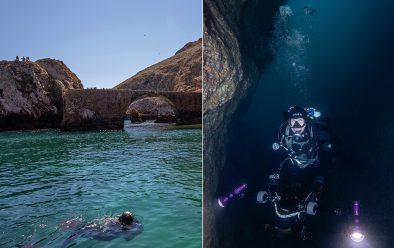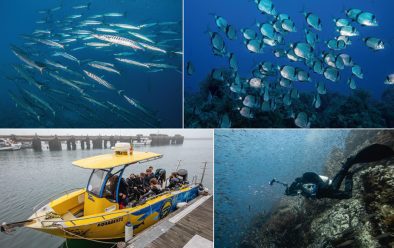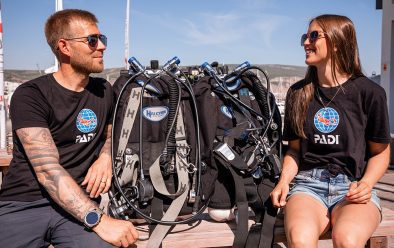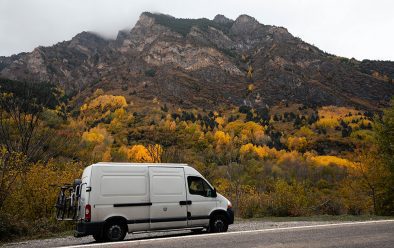EURO DIVER
Part 3
They won’t let a pandemic stop the tour – in fact despite the hurdles the diving seems to be getting better and better for Swedish film-makers LINN VENNBERG and MATTIAS GRANBERG as they hit the Iberian peninsula. If you haven’t dived there, you might be in for a surprise…

Parked at Cabo Espichel.
The same morning we were preparing to board the ferry from Dover to Dunkirk, Storm Francis blew in over the UK and France.
Our ferry was able to cross the Channel as scheduled and on the other side we set up camp to wait out the storm until we could go diving.
As in Normandy earlier, we found a dive-club with some helpful members who offered to take us diving.
Considering the recent storm our expectations were pretty low, and once in the water we discovered that the visibility was so poor we could barely see the wreck or each other. Taking photos or video was out of the question.
We still had a good day and got close topside views of the local dolphin, which usually lives around one of the area’s wrecks. And a day spent at sea in good company is always a good day. We’ll have to come back to dive in better conditions.
After that unlucky second attempt to dive the WW2 wrecks of France, we headed straight for Peniche, Portugal, and our scheduled diving in the Berlengas marine reserve. This consists of three island groups, the main island Berlenga Grande, Estelas and Farilhões-Forcadas.
Appeared in DIVER February 2021
Most of the diving is done around Berlenga Grande, and between dives it’s possible to go ashore to explore the island, relax at the beach or have lunch at the restaurant. The smaller outer islands are less frequently dived because they are more exposed.

There are a lot of scenic caves to explore around Berlenga Grande. Our favourite dive was one of the bigger ones, inhabited by a huge school of inquisitive grey triggers.
Entering the darkness to find ourselves surrounded by the fish in their hundreds moments later was a surreal experience. We spent two entire dives exploring their home and getting acquainted.
Other than that there are a lot of octopuses at dive-sites around the island and we also saw cuttlefish and schools of sea bream. At one site we spotted six John Dorys – they are residential, so it’s almost guaranteed to see them at the site.
We also made it out to Farilhões-Forcadas one day and dived a beautiful wall covered in purple gorgonians.
As a bonus, a pod of dolphins swam along beside the boat, jumping and playing in the waves on our way back on the last day. They are a common sight in this area and it was a perfect way to end our stay there.
Another highlight of Berlengas were the warm showers offered at the dive-centre. At the start of our stay in the UK camp-sites had still been closed, and when they opened they had been booked up wherever we went. In France we had found the same thing – which was why we had decided that we would never again take a proper hot shower for granted.
We do have a small outside shower with the van and the UK is full of nice lakes to swim in so we had managed to wash ourselves over the past two months, but it’s not the same as a hot shower with good water pressure. Especially on cold, rainy days.
After many good dives and almost as many hot showers we continued through Portugal to Sesimbra to dive in the Arrábida marine reserve.
The sheltered location provides good conditions for diving year round.

On the first day we dived two spots near the reserve’s central zone, where no activities, including diving, are allowed. The big boulders making up the reef were covered in gorgonians of various colours and other growth.
Around them we found many species of fish, nudibranch and octopus. The Arrábida reefs are full of life.
The next day we headed in the other direction, west from Sesimbra, to explore the wreck of a Nigerian cargo ship that sank a mile off the coast outside Cabo Espichel in 1989.
The River Gurara wreck lies in two pieces a little apart. The bow is deeper so we started there.
The surface current was so strong that we had to pull ourselves along a line to the front of the boat to reach the descent line; hard work carrying the camera.
Once down the current slowed and we had no problem making our way around the bow.
The bigger part of the wreck is quite intact, resting on its side and covered in gorgonians. There are also some swim-throughs and places to enter the wreck.
For the second dive we moved to the more broken-up stern, where the propeller and parts of the machine house can be seen. It’s a well-inhabited artificial reef, and we found both conger and moray eels, octopuses and both zebra and common two-banded sea bream.
It’s an interesting spot whether you prefer wrecks themselves or marine life.
Over the following weeks we explored the coast and beaches of southern Portugal and the winding mountain roads in Andalucia, Spain.
We visited the historical cities Alhambra and Ronda and took in the beautiful scenery in Sierra Nevada before making our way to our next diving destination, Cabo de Palos.

Outside the little fishing village lies a European hotspot, the Islas Hormigas marine reserve. Our anticipation was set so high that we were trying to dampen it to avoid disappointment as we loaded the boat for the first dive.
It took only minutes to reach the dive-site and once the boat was attached to the buoy – no anchors are to be used in the reserve – we began kitting up.
As in Sesimbra, the current at the surface was strong. We grabbed the line, pulled ourselves to the front and began descending. In the clear water we could see the pinnacle rising from the depths.
Once down we started pushing against the current around the wall but we didn’t have far to go. Within a minute we were in the middle of a school of bogue.
In autumn these fish gather in large schools in shallow waters and Islas Hormigas is the best place to experience this phenomenon. And where there are bogue, there are predators.
First to appear was a school of barracuda, slowly cruising by. They allowed us to swim beside and be surrounded by them as they inspected us.
Later a school of greater amberjack suddenly appeared and swarmed around us for several minutes before vanishing along the reef as fast as they had appeared. Common dentex swooped across the reef and mackerel were singling out and chasing the bogue with astonishing speed.
The reef was also patrolled by so many grouper that it was pointless trying to count them. Cabo de Palos and one other reserve are the places in Spain to find the largest numbers of grouper.
After that first dive, we concluded that we needn’t have worried that our expectations were set too high. This site had exceeded them.
For two weeks we dived around the reserve, and every dive was as spectacular as the first. The grouper were always there in large numbers and the dive-centre staff said that they could pretty much guarantee seeing them. We saw barracuda and common dentex on every dive.
Mackerel frequently swirled by, and at one site we were surrounded by greater amberjack hunting bogue near the surface throughout our safety stop.
One day we dived the wreck of the Isla Gomera, which sank in a storm in 1946.

It is commonly known as El Naranjito – “little orange” – because of the citrus cargo it was carrying at the time. The fruit continued to wash ashore for weeks.
The wreck is quite intact and upright.
It starts at 28m, so we would recommend diving it with nitrox. With air the bottom time was very limited and we didn’t manage to see that much of the wreck – though, as photographers/videographers, we do tend to move slowly.
Because we were staying for a while in Cabo de Palos we took the opportunity to have some things sent from home, but the package had yet to arrive when it was time to leave. We waited a couple of days, but eventually had to move on because we had only two days to get to L’Estartit.
The dive-centre kindly offered to send the package on. Of course, it arrived at the centre the day after our departure.
L’Estartit means the Medes Islands marine reserve – the place where, seven years earlier, we had taken a camera under water for the first time.
We had been in Barcelona and took a day out to do two dives around the islands. With only 20 dives or so under our belts, Mattias had invested in
a GoPro with a head-mount.
About 10 minutes into the first dive, I had discovered that there was no longer a camera on his head, and we had traced our way back to the descent-line to find it lying on the bottom.
Tip to aspiring videographers: don’t mount a camera on your head until you have learnt to manage your buoyancy and can focus on additional equipment!
The resulting footage had not been the best, but processing it had sparked an interest that led us to keep learning and evolving. We still learn something new to help us improve with every dive.
This time our first dive was at La Vaca, a tunnel covered in purple gorgonians. You can swim through it to the other side of the island. Around it swim big grouper accustomed to but still inquisitive about divers. One swam up to me to inspect my camera and, after a while, decided to taste my diffuser, a white plastic disc hanging from the strobe. Eventually classifying it as inedible, it let go and swam away.

The second day we dived in a channel between two of the islands. In the shallow part, where the seabed slopes down on each side of the islands, we found hundreds of big barracuda, stretching from the bottom to the surface.
Visibility near the seabed was not the best but closer to the surface the water cleared and we could enjoy these big predators’ company.
Floating around inside a school of barracuda is, in our opinion, one of the best experiences in diving.
For the afternoon dive we swam past a wall covered in purple gorgonians, saw a school of cow bream, got close to more grouper and were once again surrounded by a school of greater amberjack.
The way they appear out of nowhere and surround you before disappearing into the blue again is impressive.
On the last day we dived on the other side of the channel and decided to see if we could find the barracuda again.
On our way we saw more grouper, greater amberjack and common dentex – and we did find the barracuda again.
Friendly as usual, they allowed us once again to swim in their midst, giving us a glimpse of what it’s like to be a barracuda.
Talking to people working in the tourism industry in Spain, it was clear that the pandemic had affected many of them indirectly. We were told at one dive-shop that it had lost around 60% of its income for the season. What seemed to have saved dive-centres was the number of local people who had done their open-water course and discovered scuba.
The restaurants had also been forced to close again as we arrived in Catalonia, so we knew what a hard time owners and their employees were having.

We had finished diving the Islas Medes but still had to wait for our package to catch up with us. It took four days before we could continue our journey into the Pyrenees to enjoy the beautiful autumn colours in the mountains.
At higher altitudes the leaves started shifting their colours and the scenery was amazing. We hiked in the mountains on the Spanish side for a week, our plan being to continue to explore the French Pyrenees before heading back down to the coast towards Italy.
But once again Covid-19 forced us to change our plans. France was beginning to close down, and eventually decided to return to nationwide lockdown.
So as we write we are still in Spain to await developments in France and Italy, while trying to isolate ourselves as much as possible. Follow the journey on Instagram (@ocean.exposure), Facebook and YouTube (@Ocean Exposure).
We dived with…
ACUASUBOESTE in Peniche offers two dives at Berlenga Grande for 70 euros with kit-hire for 20 euro. Departure is at 9.30am and you return to harbour in the afternoon. PADI & SSI courses are taught and there are facilities for rinsing and storing kit, and changing rooms with showers, acuasuboeste.com
UNISUB L’ESTARTIT offers one dive from 36 euros, with discounts for multiple dives. Hire gear costs 16 euros for the first dive, then 12.5 euros. There is one dive in the morning, one in the afternoon. The centre offers PADI courses and can arrange accommodation and stay-and-dive package deals. Kit can be rinsed and stored on the boat, unisub.es
 DIVERS CABODE PALOS (pictured) charges 45 euros for a dive at Islas Hormigas marine reserve, with packages such as four dives for 158 euros. It does PADI courses, has facilities for rinsing and storing gear, kit-hire and changing rooms with showers. It can arrange accommodation, diverscabodepalos.com
DIVERS CABODE PALOS (pictured) charges 45 euros for a dive at Islas Hormigas marine reserve, with packages such as four dives for 158 euros. It does PADI courses, has facilities for rinsing and storing gear, kit-hire and changing rooms with showers. It can arrange accommodation, diverscabodepalos.com
DIVE CLUB CIPREIA in Sesimbra does two dives for 64 euros with kit-hire for 20 euros, morning or afternoon. It does SSI courses and has rinsing and kit-storage and changing rooms with showers, diveclubcipreia.com

